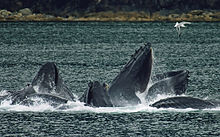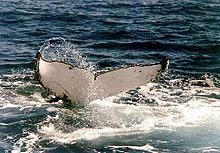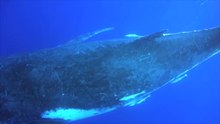Humpback whale
| Humpback whale | ||||||||||||
|---|---|---|---|---|---|---|---|---|---|---|---|---|

Humpback whale |
||||||||||||
| Systematics | ||||||||||||
|
||||||||||||
| Scientific name of the genus | ||||||||||||
| Megaptera | ||||||||||||
| JE Gray , 1846 | ||||||||||||
| Scientific name of the species | ||||||||||||
| Megaptera novaeangliae | ||||||||||||
| ( Borowski , 1781) |
The humpback whale ( Megaptera novaeangliae ) is a representative of the furrow whales that often occurs near the coast . It reaches a height of 12 to 15 meters and has significantly larger flippers compared to other whales . The animals are known, among other things, for their whale song and their liveliness. As a result of the intensive hunting , the worldwide populations temporarily declined threateningly. The humpback whale has been under worldwide species protection since 1966 .
features
With an average length of around 13 meters, humpback whales are relatively small baleen whales , they reach a maximum length of 18 meters. The weight is 25 to 30 tons. The body is very strong compared to all other furrow whales. The color is black on the top and on the underside to the flanks , depending on the population and also the individual color, white to black; Scar tissue in the form of white spots is caused by the barnacle infestation on the body, and the body can be overgrown with golden yellow diatoms . The rostrum is flat and equipped with typical tubercles , nodular skin thickenings, on each of which there are one or two bristles . The blowholes are centrally located on the head. The humpback whale has 14 to 20 throat furrows that extend from the chin to the navel . The beards are found in the mouth, each standing in rows of 270 to 400 individual beards . The whales can be 0.8 to 1.0 meters long and are rather coarse compared to those of other baleen whales.
The pectoral fins are much larger than that of any other whale , reaching almost a third of the body length. They are equipped with bumps and nicks on the front, on which barnacles can also stick . The dorsal fin is comparatively tiny and very variable in shape and size. It stands on a small bead of bubbling and can be elongated, triangular or sickle-shaped. The fluke is again very large and deeply indented. The rear edge is very rough.
distribution and habitat

The humpback whale lives in all oceans . The summer roosts are in polar seas, the winter roosts in tropical and subtropical waters, whereby the animals are mainly in shallow sea zones. They cross deeper sea areas on their migrations between summer and winter areas. During their migrations, humpback whales prefer waters close to the coast and invade bays and estuaries. Humpback whales are occasionally observed, for example, in the western Baltic Sea ; in summer 2014 two specimens were sighted in the Flensburg Fjord , in July 2016 one animal in the Greifswalder Bodden ; and in June 2018 a dead humpback whale was recovered from Graal-Müritz ( Mecklenburg-Western Pomerania ).
Depending on the population, the hikes can cover thousands of kilometers. It is assumed that the individual populations do not cross the equator , so that there is a northern and a southern population in both the Pacific and the Atlantic , which remain separated by the seasonal migration. While the southern animals migrate to the Southern Ocean in summer , the northern animals spend the summer in the waters of the Arctic Ocean . An exception is the Indian Ocean population, which cannot migrate north. Some of these remain in the nutrient-rich marine areas of the tropical zone even in summer, and some of them also migrate to the Southern Ocean.
Way of life
nutrition
The diet of the humpback whales consists mainly of krill and to a small extent also of fish , the latter mainly in the northern range. It is only eaten in the summer roosts, in winter humpback whales feed on their fat reserves . The whales find their food in water depths of up to 50 meters. They belong to the "swallow filters", for which the food must be present in relatively dense swarms. The whale swims into these schools with its mouth open and then usually dives with its mouth full. On the surface this takes place horizontally, from greater depths the whale rises vertically. In the latter case, the whale produces a curtain of rising air bubbles to concentrate the food. Depending on the size of the prey swarm, several whales can join together and synchronize their catch.
Locomotion and registration
Humpback whales are fast swimmers, with migration speeds between 1.5 and 11.0 kilometers per hour with an average speed of 2 to 5 kilometers per hour. The top speed measured was up to 27 kilometers per hour, which the animals can reach in a very excited state.
Its diving behavior is also characteristic, in which it descends with the formation of a hump. This behavior is the reason for its name. In addition, it regularly lifts its tail fin completely out of the water when diving. The dives rarely last longer than 15 minutes, depending on the food density, and only reach an average of three to nine minutes. In the winter roosts, the animals dive on average for up to 30 minutes. The blow of humpback whales is unidirectional and often bushy and can be easily distinguished from the other species of whales.
The animals are also characterized by acrobatic jumps, during which they rise out of the water with their entire bodies. In addition to these jumps, they often clap their flippers or fluke on the surface of the water, creating loud popping noises.
Social behavior and communication
Humpback whales live mostly alone or occasionally for hunting and mating in small groups of two to nine animals. Cows with newborns are often accompanied by a bull who defends them against intrusive other whales. In the area of the foraging grounds and also the breeding grounds, however, they also come together to form larger groups, although the individual groups continue to move independently of one another. For the food grounds, however, it has been shown that groups of several animals meet here every year, they hunt together and their composition can be stable for years.
During the breeding season, the male animals sometimes behave very aggressively towards one another, threatening, ramming and pushing each other with their mouths open. The injuries that occur during these fights are mostly only superficial, but leave clear scars on the back skin of the animals. The mating behavior is polygamous , the individual animals mate accordingly with several partners, which explains the aggressiveness of the males among one another.
Another aspect of behavior during the mating season is the characteristic song of humpback whales. All baleen whales make sounds, but humpback whales have the greatest variety of voices. A research group from the University of Queensland registered 622 different sounds in a study published in 2007. The song of the humpback whale is one of the most multifaceted animal sounds and is mainly produced by male animals underwater. The singing consists of individual stanzas that are repeated regularly, are typical of the individual and change over the years. With an impressive volume of 190 decibels , the singing itself is one of the loudest calls in the animal kingdom. A detailed description of the humpback whale song can be found under Song of the humpback whales .
Sound recordings of humpback whales:
Near the remote Ogasawara Islands, 1,000 km south of Tokyo, where a ship only sails once a day, it was found in 2018 that humpback whales near a passing ship reduce or stop singing and typically only resume half an hour later.
Reproduction and development
The reproduction of the humpback whales takes place in the winter quarters in tropical waters. This leads to the male rivalry already described and to their singing. Pairs usually stay together for a few hours and both partners mate with other animals.
The gestation period of the females is about twelve months and the young are accordingly born again in the breeding waters. The young are around 4 meters tall at birth and stay with the mother for at least a year, with the suckling period taking up the first six to ten months and the young reaching a size of 7.5 to nine meters. After that they can either join another group or separate from the group and move alone. The females can give birth again at intervals of about three years.
A humpback whale becomes sexually mature when it is 5 years old and around 12 meters tall, and it will reach its final size after around 15 years. The oldest animal found so far was 48 years old, the age being calculated using the growth rings on the ear capsule .
Behavior towards predators
Humpback whales are often targeted by killer whales , especially cows with calves. The humpback whales are therefore likely to disturb the orcas when they hunt. The team of whale researchers Robert Pitman and John Durban have made several observations that sturgeon maneuvers have prevented killer whales from hunting seals , sea lions and other whales. In one case, two humpback whales attempted to rescue a gray whale calf attacked by killer whales . In another case, a seal was saved from attack by a killer whale by a humpback whale. The marine biologist Nan Hauser believes she was protected from a tiger shark by a humpback whale .
Systematics
Among the furrow whales, the humpback whale is the only representative of the genus Megaptera , which is monotypical . It is compared to all other furrow whales that are grouped together in the genus Balaenoptera , as a sister species . By molecular biology a close relationship between the humpback, the studies was Grauwal ( Eschrichtius robustus ) and the blue whale ( Balaenoptera musculus ) is determined which is to be thus more closely related to these two types as with all the other species of the genus Balaenoptera. On the other hand, there are currently eleven documented cases of blue whale / fin whale crossbreeding in the wild.
The name Megaptera ("large wing") is derived from its very large flippers . The epithet novaeangliae ( New England ) he received from its first describer GH Borowski, who described it in 1781 as Balaena novaeangliae . The classification in a separate genre took place in 1932.
Whaling and Protection
It is now assumed that before the massive human intervention in the whale populations, around 125,000 humpback whales lived around the world, around 100,000 of them south of the equator. The animals were hunted on a small scale in ancient times, but on a large scale since the 17th century. After the humpback whale population had decreased to a few thousand animals due to heavy hunting, it was able to recover strongly thanks to the global fishing ban of 1966. The IUCN assumes more than 60,000 animals worldwide and has classified the humpback whale in the lowest risk level of the Red List (LC = "least concern") since 2008. According to the reports of the International Whaling Commission (IWC) and NOAA, an estimated 25,000 humpback whales currently live in the southern seas (as of mid-2011), around 20,000 animals live in the North Pacific while a population of 11,500 animals can be assumed in the North Atlantic, plus smaller, scattered ones Populations on the American west coast, the Gulf of Maine, Samoa, and other areas.
Because it approaches the coast and is not particularly large, the humpback whale is easier to hunt than other large whales . That is why it was one of the first species of large whales to be hunted. Its occurrence was easy to calculate in both breeding and feeding grounds, so it was hunted both there and on the trails. As early as the end of the 19th century, the stocks in the North Atlantic were severely reduced, whereupon the whale hunt began to be concentrated on the larger southern populations. More than 100,000 animals were killed in the first half of the 20th century. Around 1920 the annual catch quotas dropped rapidly from 14,000 to 2,000 animals per year, as the whales had become rare and less interesting for the markets. Between 1940 and 1963 there was more hunting and another 50,000 humpback whales were killed in these years and the population of the North Atlantic, which was just recovering, was placed under international protection, and in 1963 the populations of the southern hemisphere. In 1966 there was a total fishing ban, the only exception being the traditional whaling of the people of the Caribbean island of Bequia . The residents are allowed to kill up to four humpback whales a year for their own consumption, but this number was never reached and today there are no more whalers there. Up to the end of 1978 about eight animals per year were shot off Tonga and up to the end of 1985 up to ten animals per year off West Greenland .
In 2007, Japan announced on November 18 that it would start the first large humpback whale hunt since 1963 with the 8,000-ton Nisshin Maru - at the same time the largest hunt since the protective measures of the International Whaling Commission (IWC) began. To do this, the fishermen wanted to use an exemption for scientists. In fact, most of the whales killed were supposed to be sold to restaurants. The plan was to kill up to 50 humpback whales, up to 50 fin whales and up to 935 southern minke whales with the harpoon. After international pressure, Japan stopped hunting humpback whales.
Individual evidence
- ↑ Whale mystery cleared: A humpback whale was seen in the Greifswalder Bodden. In: nordkurier.de. Retrieved September 7, 2016 .
- ↑ Dead humpback whale: cause of death still unclear. In: ndr.de. Retrieved June 11, 2018 .
- ↑ Singing whales make small talk too www.abc.net.au November 20, 2006, accessed January 24, 2019
- ↑ Humpback whales do not sing near ships orf.at, October 25, 2018, accessed October 25, 2018.
- ↑ Meike Seibert: Mobbing among whales, Bild der Wissenschaft 12/2016, p. 16.
- ↑ [1] Video from the BBC series Planet Earth
- ↑ Orca VS calf: the incredible story , humpback whales help a young gray whale against killer whales, November 4, 2017.
- ↑ Diver: A humpback whale saved my life from a shark Hessische / Niedersächsische Allgemeine from January 14th, 2018 and a quote from the video A marine biologist says a humpback whale saved her from a shark by BBC on January 10th, 2018
- ↑ Maurizio Würtz, Nadio Repetto 1998
- ↑ Spiegel Online: "Japan starts large hunt for humpback whales - the first in 44 years" , November 17, 2007
- ↑ Neue Zürcher Zeitung: "Japan partially gives way to international pressure" , December 21, 2007
literature
- Mark Carwardine: Whales and Dolphins . Delius Klasing, Bielefeld 2008, ISBN 978-3768824736 . (high quality guide)
- Mark Carwardine et al. a .: Dolphins & whales. Understand - recognize - observe . Gondrom-Verlag, Bindlach 2005, ISBN 3-8112-2593-6 . (Paperback edition)
- Ralf Kiefner: whales and dolphins worldwide . Year Top Special, Hamburg 2002, ISBN 3-86132-620-5 . (Guide to the magazine "Tauchen", very detailed)
- J. Niethammer, F. Krapp (ed.): Handbook of mammals in Europe. Vol. 6. Marine mammals, part 1A: whales and dolphins 1. AULA-Verlag, Wiesbaden 1994, ISBN 3-89104-559-X . (very detailed textbook)
- RR Reeves, BS Stewart, PJ Clapham, JA Powell: Sea Mammals of the World - a complete Guide to Whales, Dolphins, Seals, Sea Lions and Sea Cows . A&C Black, London 2002, ISBN 0-7136-6334-0 . (Guide with numerous pictures)
- Maurizio Würtz, Nadio Repetto: Underwater world. Dolphins and Whales . White Star Guides, Vercelli 2003, ISBN 88-8095-943-3 . (Determination book)
- Maurizio Würtz, Nadio Repetto, Manferto, Valeria (eds.): Wale & Delphine, Biography of the Marine Mammals . Jahr Verlag, Hamburg 1998, ISBN 3-86132-264-1 .










